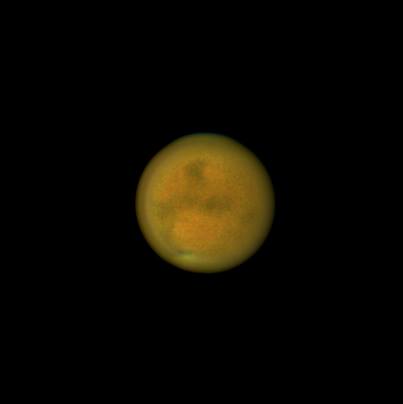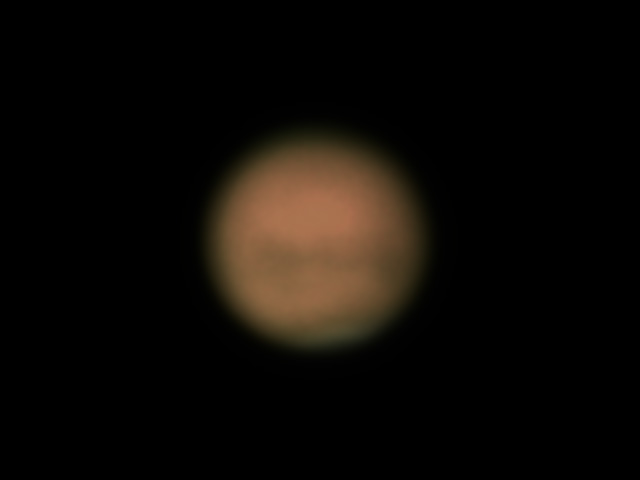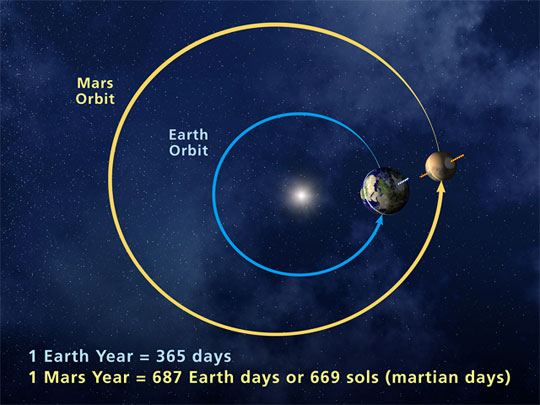On July 30-31, 2018, Mars and Earth are closer than since their historically close approach in 2003. Mars was closer in 2003 than in some 60,000 years, and it’s now only slightly farther from Earth now than then. It’s some 35.78 million miles (57.59 million km) away at its closest on July 31 at 8 UTC. That time places Mars’ closest approach before sunrise on July 31 for North American time zones – and on July 30 at 10 p.m. Hawaiian Time.
This July 30-31, 2018 close encounter between the Earth and Mars is the closest until around the time of the Martian opposition on September 15, 2035.
Read more: The cycle of close and far Mars oppositions
Mars is closest in spite of the fact that Earth passed between Mars and the sun (the Martian opposition) on July 27. Read more about why below.
How about viewing Mars through a telescope now? Is it a good time? Is this a great time to look at Mars through a telescope? It should be because Mars is larger in our sky now, as illustrated below:
Mars last came to opposition in 2016. It appeared smaller in our sky then, in comparison to 2018, as viewed through a telescope. Illustration via nasa.tumblr.com.
The telescopic view of Mars hasn’t been so great. Why not?
The answer is that planet-wide dust storms tend to spring up on the red planet around the time Mars is closest to the sun. Mars closest point to the sun happens on September 16, 2018. Dust storms on Mars began kicking up a few months ago, and the dust storms went global on Mars in early June.
That’s why most telescopic images of Mars we’ve seen this summer have looked like those below:

Jim Powell wrote: “Mars at 3 a.m. July 15, 2018. Only 12 days away from opposition, and it looks like those dust storms are starting to calm down a little bit. I’m seeing more detail today than I did 9 days ago when I last observed Mars.” Click here for updates on the Opportunity rover on Mars; it went silent in June due to Mars dust.

Rob Pettengill in Austin, Texas captured this image of Mars on July 23, 2018. He wrote: “Dusty Mars captured with a small telescope. Good seeing conditions in Austin gave me a chance to capture hints of surface detail and the south polar cap for the first time during this dust obscured opposition.”
Animation illustrating the effects of dust on our view of the Red Planet, via NASATumblr.
Why aren’t we closest to Mars on the day we pass between it and the sun? If both the Earth and Mars circled the sun in perfect circles, and on the same exact plane, the distance between Earth and Mars would always be least on the day of Mars’ opposition. But we don’t live in such a symmetrical universe. All planets have elliptical orbits and a perihelion (closest point) and aphelion (farthest point) from the sun.
Mars’ orbit around the sun takes 687 days in contrast to 365 days for Earth. It has a year nearly twice as long as ours. Earth’s closest point to the sun comes yearly, in January. Mars will be closest to the sun next on September 16.
At its opposition on July 27 – when Earth was directly between Mars and the sun – Mars was still drawing closer to the sun. And that is how its distance from us is smaller on July 31 than when Earth passed between the sun and Mars.
The time interval between a Mars’ opposition and its least distance from Earth can be as long as 8.5 days (1969), or as little as 10 minutes (2208 and 2232).
Generally speaking, Mars is brightest in 2018 from about July 7 to September 7. It is now shining more brilliantly than the planet Jupiter, and it’s not very often that Mars outshines the king planet!
View larger. | On July 24, 2018, in Kalispell, Montana, John Ashley captured the images to make this composite. The bright object here is the moon, and the 2nd-brightest is Mars. You can see Jupiter in the top right, and Saturn just below the moon. Notice Mars is brighter than both Jupiter and Saturn! Read more about this image.
Is Mars brightest when it’s closest? Not necessarily.
You might think Mars should be brighter when closest to Earth on July 30-31 than at opposition on July 27. But it’s not (although it’s still plenty bright).
Mars is a tiny bit fainter now than at its July 27 opposition. That’s because of something known as opposition surge. Mars most directly reflects sunlight back to Earth at opposition. This directness accentuates Mars’ brilliance. Before and after opposition, sunlight is reflected at a slightly slanted angle relative to Earth, thereby reducing Mars’ brightness.
Earth swings between Mars and the sun every other year, at progressively later dates. Earth will next lap Mars on October 13, 2020. Its closest approach to Earth that year will be October 6. After that, Earth will next lap Mars on December 8, 2022, but its closest approach will come one week earlier, on December 1, 2022. At both of those oppositions of Mars – and at every opposition for some years to come – Mars will appear fainter, and fainter, in our sky. That’s because those oppositions will happen farther and farther from Mars’ perihelion date.
So enjoy Mars in 2018! You won’t see it this bright again for many years.
Mars is out almost all night long now. It looks like a bright reddish “star,” shining with a steadier light than the true stars. In late July and August, 2018, for Mars in the east at nightfall – highest in the sky near midnight – and in the west as morning dawn starts to light the sky.
Clouded out tonight? Look tomorrow or the next night! Mars will remain very bright in our sky until about early September. Then its fabulous 2018 appearance in our sky will be done, and Mars will begin to fade. We’ll have to wait until 2035 to see it this bright again!
Read more: The cycle of close and far Martian oppositions
Mars will still be visible after July and August, 2018, but each month it will shrink in apparent size as Earth rushes ahead of Mars in our smaller, faster orbit around the sun. As telescopes show Mars smaller in apparent sky, our unaided eyes will see Mars fade in brightness. Image via NASATumblr.
Bottom line: The Mars opposition – when Earth flew between the sun and Mars – was July 27, 2018. But the distance between Mars and Earth is least on July 30-31, 2018.
from EarthSky https://ift.tt/2AlJ56y
On July 30-31, 2018, Mars and Earth are closer than since their historically close approach in 2003. Mars was closer in 2003 than in some 60,000 years, and it’s now only slightly farther from Earth now than then. It’s some 35.78 million miles (57.59 million km) away at its closest on July 31 at 8 UTC. That time places Mars’ closest approach before sunrise on July 31 for North American time zones – and on July 30 at 10 p.m. Hawaiian Time.
This July 30-31, 2018 close encounter between the Earth and Mars is the closest until around the time of the Martian opposition on September 15, 2035.
Read more: The cycle of close and far Mars oppositions
Mars is closest in spite of the fact that Earth passed between Mars and the sun (the Martian opposition) on July 27. Read more about why below.
How about viewing Mars through a telescope now? Is it a good time? Is this a great time to look at Mars through a telescope? It should be because Mars is larger in our sky now, as illustrated below:
Mars last came to opposition in 2016. It appeared smaller in our sky then, in comparison to 2018, as viewed through a telescope. Illustration via nasa.tumblr.com.
The telescopic view of Mars hasn’t been so great. Why not?
The answer is that planet-wide dust storms tend to spring up on the red planet around the time Mars is closest to the sun. Mars closest point to the sun happens on September 16, 2018. Dust storms on Mars began kicking up a few months ago, and the dust storms went global on Mars in early June.
That’s why most telescopic images of Mars we’ve seen this summer have looked like those below:

Jim Powell wrote: “Mars at 3 a.m. July 15, 2018. Only 12 days away from opposition, and it looks like those dust storms are starting to calm down a little bit. I’m seeing more detail today than I did 9 days ago when I last observed Mars.” Click here for updates on the Opportunity rover on Mars; it went silent in June due to Mars dust.

Rob Pettengill in Austin, Texas captured this image of Mars on July 23, 2018. He wrote: “Dusty Mars captured with a small telescope. Good seeing conditions in Austin gave me a chance to capture hints of surface detail and the south polar cap for the first time during this dust obscured opposition.”
Animation illustrating the effects of dust on our view of the Red Planet, via NASATumblr.
Why aren’t we closest to Mars on the day we pass between it and the sun? If both the Earth and Mars circled the sun in perfect circles, and on the same exact plane, the distance between Earth and Mars would always be least on the day of Mars’ opposition. But we don’t live in such a symmetrical universe. All planets have elliptical orbits and a perihelion (closest point) and aphelion (farthest point) from the sun.
Mars’ orbit around the sun takes 687 days in contrast to 365 days for Earth. It has a year nearly twice as long as ours. Earth’s closest point to the sun comes yearly, in January. Mars will be closest to the sun next on September 16.
At its opposition on July 27 – when Earth was directly between Mars and the sun – Mars was still drawing closer to the sun. And that is how its distance from us is smaller on July 31 than when Earth passed between the sun and Mars.
The time interval between a Mars’ opposition and its least distance from Earth can be as long as 8.5 days (1969), or as little as 10 minutes (2208 and 2232).
Generally speaking, Mars is brightest in 2018 from about July 7 to September 7. It is now shining more brilliantly than the planet Jupiter, and it’s not very often that Mars outshines the king planet!
View larger. | On July 24, 2018, in Kalispell, Montana, John Ashley captured the images to make this composite. The bright object here is the moon, and the 2nd-brightest is Mars. You can see Jupiter in the top right, and Saturn just below the moon. Notice Mars is brighter than both Jupiter and Saturn! Read more about this image.
Is Mars brightest when it’s closest? Not necessarily.
You might think Mars should be brighter when closest to Earth on July 30-31 than at opposition on July 27. But it’s not (although it’s still plenty bright).
Mars is a tiny bit fainter now than at its July 27 opposition. That’s because of something known as opposition surge. Mars most directly reflects sunlight back to Earth at opposition. This directness accentuates Mars’ brilliance. Before and after opposition, sunlight is reflected at a slightly slanted angle relative to Earth, thereby reducing Mars’ brightness.
Earth swings between Mars and the sun every other year, at progressively later dates. Earth will next lap Mars on October 13, 2020. Its closest approach to Earth that year will be October 6. After that, Earth will next lap Mars on December 8, 2022, but its closest approach will come one week earlier, on December 1, 2022. At both of those oppositions of Mars – and at every opposition for some years to come – Mars will appear fainter, and fainter, in our sky. That’s because those oppositions will happen farther and farther from Mars’ perihelion date.
So enjoy Mars in 2018! You won’t see it this bright again for many years.
Mars is out almost all night long now. It looks like a bright reddish “star,” shining with a steadier light than the true stars. In late July and August, 2018, for Mars in the east at nightfall – highest in the sky near midnight – and in the west as morning dawn starts to light the sky.
Clouded out tonight? Look tomorrow or the next night! Mars will remain very bright in our sky until about early September. Then its fabulous 2018 appearance in our sky will be done, and Mars will begin to fade. We’ll have to wait until 2035 to see it this bright again!
Read more: The cycle of close and far Martian oppositions
Mars will still be visible after July and August, 2018, but each month it will shrink in apparent size as Earth rushes ahead of Mars in our smaller, faster orbit around the sun. As telescopes show Mars smaller in apparent sky, our unaided eyes will see Mars fade in brightness. Image via NASATumblr.
Bottom line: The Mars opposition – when Earth flew between the sun and Mars – was July 27, 2018. But the distance between Mars and Earth is least on July 30-31, 2018.
from EarthSky https://ift.tt/2AlJ56y


Aucun commentaire:
Enregistrer un commentaire